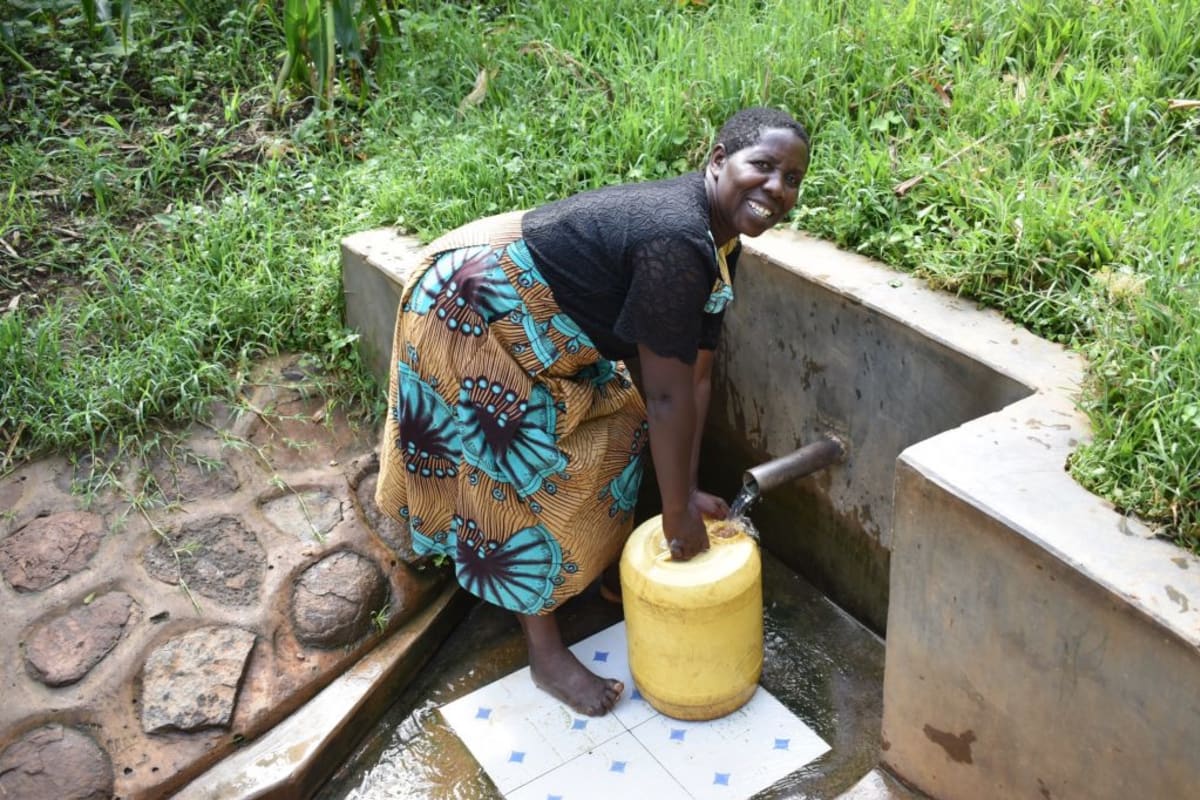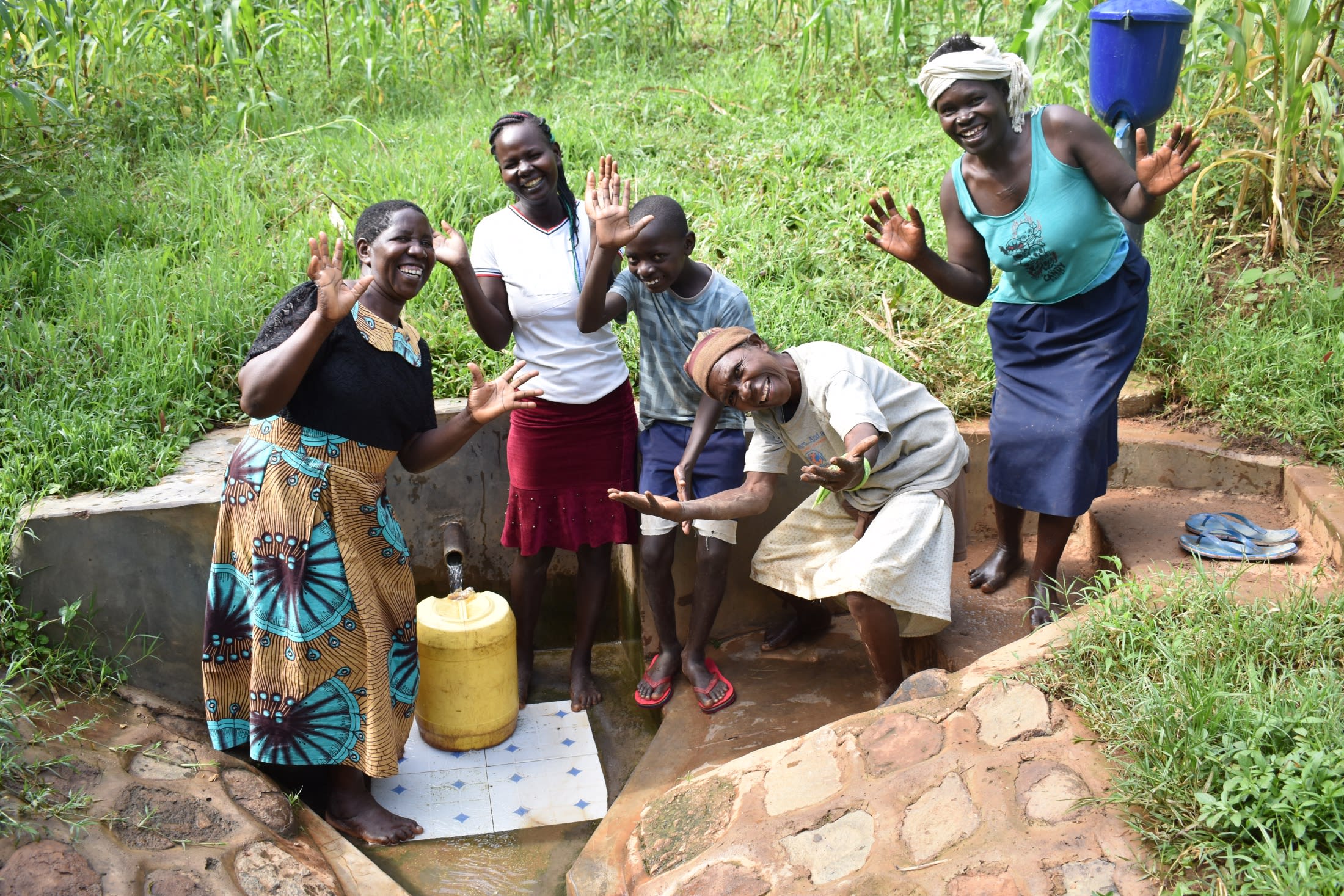June, 2021: Wambani Spring Project Complete!
Musango Community now has access to clean water! We transformed Wambani Spring into a flowing source of water, thanks to your donation. Our team protected the spring and trained the community on improved sanitation and hygiene practices, including COVID-19 prevention.

Women celebrating at the protected spring.
"The protected spring will help me reduce the distance I have been covering going to get clean water at a very far distance. It will help me have water at my house always without being worried about the distance," said Florence Otipa, a businessperson in the community.
"I will be able to expand my business because I will have enough time to take my fish to the market. We have been being charged 50 bob (KSH) per month to fetch water from the other spring where we have been getting water - I will save that money and expand my business with it," she added.
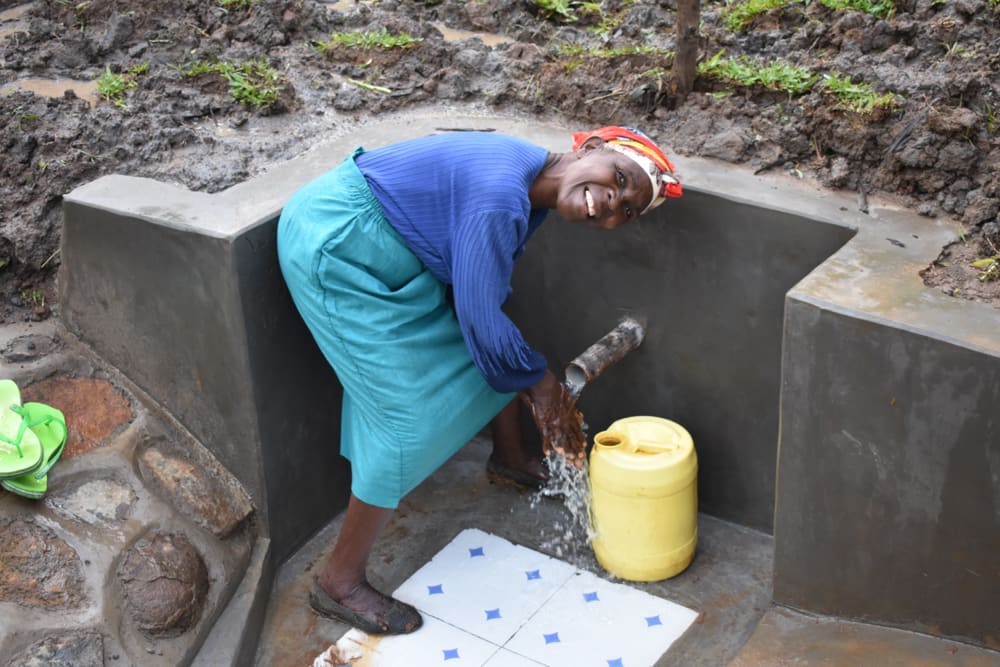
Children were just as excited as the adults about the new water point.
"The spring will help me have drinking water near my home. I will not be going to look for water elsewhere. I will be having time for evening studies since water is easily accessible. I will dedicate extra time to studies to improve on my performance," said teenager Gabriel.

Gabriel (left) and others celebrating at the protected spring.
"Musango community had been fetching water from a very far distance which they were being charged for to put them off from fetching water from there. They were very happy when they realized that they will now own their own water point," recalled Programs Coordinator Protus Ekesa, who helped bring this project to fruition.
"During construction, the community put in a lot of effort. They did everything collectively as a community. They mobilized materials so that their work should be done well and speedily. The community was also able to clear the path leading to the spring, which they had ignored for a very long time."

Programs Coordinator Protus Ekesa (left) marks the official handing over of the spring through a gesture to the community members.
"On the training day, they turned up happily to get knowledge on the use of their water source. During this time, they could also learn how to keep themselves safe from the COVID-19 pandemic. They had relaxed in adherence to the COVID-19 measures as stipulated by the Ministry of Health. They were taught in practice how to wash their hands, how to wear face masks appropriately, and how to make a simple mask and handwashing station at home."

Preparing for Spring Protection
Community members worked together to source and carried all locally available construction materials to the spring. These included bricks, sand, stones, and fencing poles. Some people also chiseled away at large stones to break them down into the gravel. Because people have to carry most items by hand, the materials collection process can take anywhere from a few weeks to months.

Community members bringing construction materials to the spring work site.
When everything was prepared, we sent a lorry to the community to deliver the rest of the construction materials, including the cement, plastic tarps, and hardware. Then, our artisan and field officers deployed to the spring to begin work. Individual households provided meals throughout each day to sustain the work team.

Community members of all ages and abilities helped prepare and mobilize materials for construction.
From Open Source to Protected Spring: A Step-by-Step Process
At last, it was time to dig in at the spring! Women and men lent their strength to the artisan each day to help with the manual labor. First, we cleared and excavated the spring area. Next, we dug a drainage channel below the spring and several surface runoff diversion channels above and around the spring. These help to divert environmental contaminants carried by the rains away from the spring.

Excavation
To ensure community members could still fetch water throughout the construction process, we also dug temporary diversion channels from the spring’s eye around the construction site. This allowed water to flow without severely disrupting community members’ water needs or the construction work.
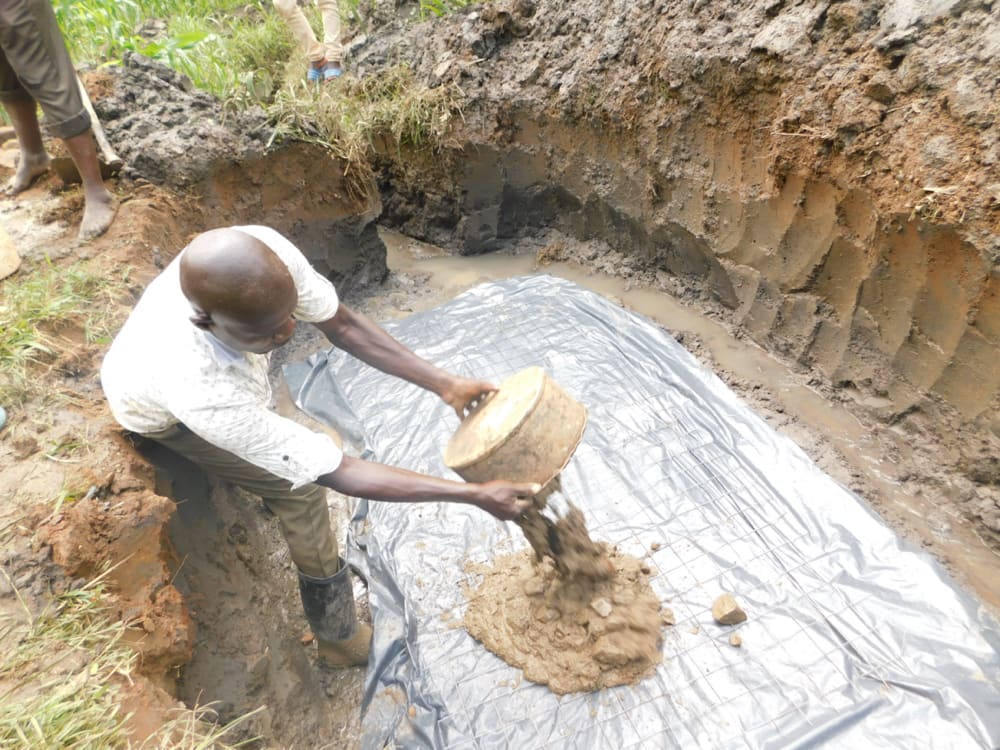
Pouring the foundation
Excavation created space for setting the spring’s foundation made of thick plastic tarp, wire mesh, concrete, and waterproof cement. After setting the base, we started brickwork to build the headwall, wing walls, and stairs.
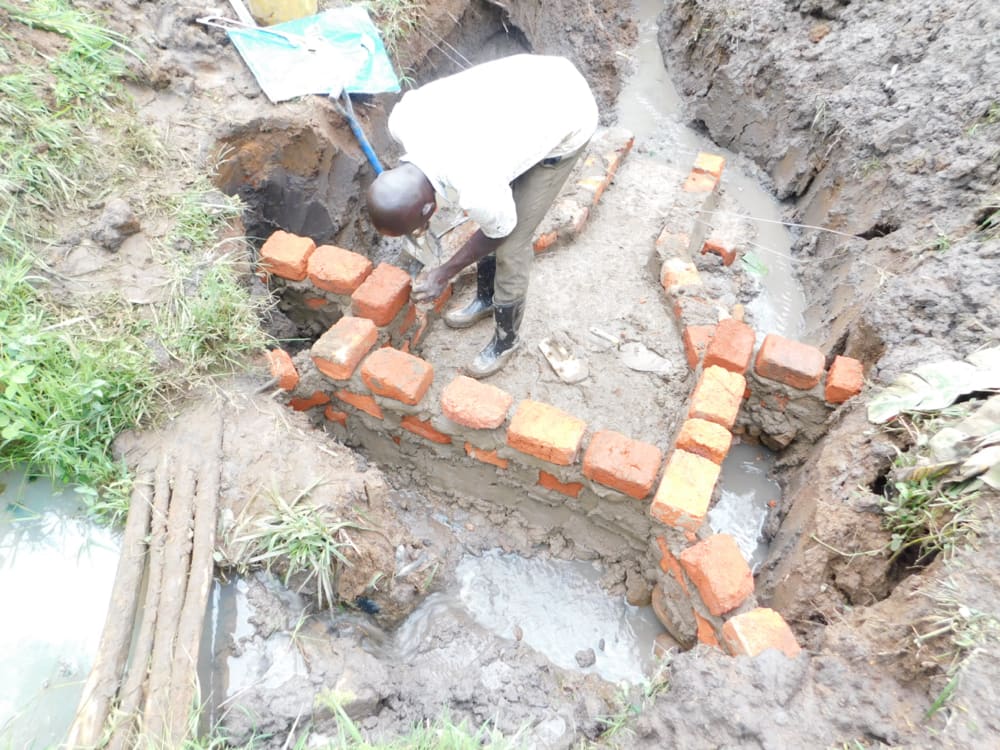
Brickwork begins
Next, we began one of the most crucial spring protection steps to ensure a fully functional water point: setting the discharge pipe. The discharge pipe has to be low enough in the headwall so that the water level inside never rises above the spring’s eye, yet high enough to leave eighteen to twenty inches between the pipe and the spring floor. This allows room for the average jerrycan (a 20-liter container) to sit beneath the pipe without making contact.

Setting the pipe
If we place the discharge pipe too high above the spring’s eye, too much backpressure could force the flow to emerge elsewhere. Too low, and community members would not be able to access the water easily. We embedded the pipe using clay (or mortar when the clay is in short supply) and placed it slightly incline to ensure water flows in the right direction.

The walls reach their final height with bricks.
In coordination with brickwork, we pitched medium to large stones on both sides of the spring’s drainage channel. We then cemented and plastered each stone group into place, forming the rub walls. This helps discourage people and animals from standing in that area, which could cause soil erosion and thus a clogged drainage area.

Stone pitching underway looking toward the spring's drainage channel
We turned to cementing and plastering both sides of the headwall and wing walls with brickwork and stone pitching completed. These finishing layers reinforce the brickwork and prevent water in the reservoir from seeping through the walls. In turn, enough pressure builds in the reservoir box to push water out through the discharge pipe.

Rock hand-off line to help the artisan backfill the spring.
As the headwall and wing walls were curing, we cemented and plastered the stairs and installed four tiles beneath the discharge pipe. The tiles protect the concrete from the falling water’s erosive force while beautifying the spring and facilitating easy cleaning of the spring floor.

Backfilling
We transitioned to the final stages of construction with the tiles in place - backfilling the reservoir box. First, we cleared the collection box of any debris that may have fallen in since its construction, such as dead leaves or other items. Then we redirected the temporary diversion channels back into the reservoir box, channeling water into this area for the first time. We closed off all of the other exits to start forcing the water through the discharge pipe only.

Backfilling
With much help from the community, we filled up the reservoir area with the clean and large stones they gathered, arranging them in layers like a well-fitting puzzle. We covered the stones with a thick plastic tarp to minimize potential contamination sources from aboveground, followed by a layer of soil. We piled enough soil on top to create a slight mound to compensate for the backfill’s future settlement.

Setting up the fence
Community members transplanted grass onto the backfilled soil to help prevent erosion. Finally, the collection area was fenced to discourage any person or animal from walking on it since compaction can lead to disturbances in the backfill layers and potentially compromise water quality.

Planting grass
The entire construction process took about two weeks of work and patience to allow the cement and plaster to finish curing. As soon as it was ready, people got the okay from our field officers to fetch water.
"There was a celebration at the water point during the handing-over ceremony as the community members were excited to have their own water. They have been paying money to fetch water from the nearby spring, which is not very close to their homes. The community sang local songs and danced at the water point. The cane cutters who were cutting sugarcane nearby were forced to abandon their work to come and witness what was happening at the spring," recalled Programs Coordinator Protus Ekesa, who led the ceremony at the spring.

Protus hands over the spring to the community.
Training on Health, Hygiene, COVID-19, and More
Due to the ongoing challenges and restrictions amidst the pandemic, we worked with local leaders and the national Ministry of Health to gain approval for a small group training about health, hygiene, and COVID-19 prevention.
Together with the community, we found their preferred date for training while considering other community calendar events, such as the agricultural season and social events. We requested a representative group of community members to attend training to relay the information learned to the rest of their family and friends.

Handwashing demonstration
When the day arrived, facilitators Protus, Adelide, Elvine, and Joyce deployed to the site to lead the event. Fourteen people attended the training, including community-based leaders and the village health volunteer. We held the training at the spring and one of the community members' homes. The environment was cool but rather muddy at the spring since it had rained heavily the day before. The venue was spacious and open at the home, helping to accommodate the number of community members while adhering to the COVID-19 protocols.

Handwashing practice
Perhaps the most crucial topic of the day was our session on COVID-19 prevention and control. Due to the rampant spread of misinformation about COVID-19, we dedicated time to a question and answer session to help debunk rumors about the virus and provide extra information where needed. When we touched on how handwashing is an effective step at helping to prevent the spread of COVID-19, the facilitator asked the community members if they wash their hands regularly. One man named Joseph replied by saying that they had stopped washing their hands as they used to do when the first COVID-19 case was announced in Kenya. The facilitator reminded them that COVID-19 is here with us, and they need to be even more vigilant than before. This led the community health volunteer who was present to explain to the group how serious COVID-19 is so as for them to take care of themselves.

Participants put on masks to attend training.
We covered several other topics, including community participation in the project; leadership and governance; personal and environmental hygiene; water handling and treatment; operation and maintenance of the spring; dental hygiene; the ten steps of handwashing, and how to make and use a tippy tap and leaky tin. In addition, we held an election for the newly formed water user committee leaders during the leadership and governance session.

Site management training at the spring
We also brainstormed income-generating activities that can be used to start community savings account for any future minor repairs to the spring and a cooperative lending group to enable members to develop small businesses.
"The training has made me learn things I had not learned before. It is going to help me remain safe from the virus and also be in a position to pass the knowledge to my family," said Dishon Kutsushi, the elected Chair of the water user committee and also a Pastor in the community.

Active question and answer session
"The training has taught me so much on what I am supposed to do as an individual in terms of ensuring I remain safe during this pandemic and also having access to clean and safe drinking water. I will be able to use the new knowledge to train my people, which makes my work easier," said Hellena Anyesi Lukoko, the Community Health Volunteer and the elected Secretary of the water user committee.

Community Health Volunteer Madam Hellena Lukoko urges her fellow community members to visit a health facility when they feel ill.
Madam Lukoko said the most helpful parts of the training included "the ways of handwashing, the symptoms and signs of COVID-19 as compared to the normal cold, and how to make a simple handwashing station at home."
"For now, I am not worried because I have acquired the knowledge to protect myself and protect the community at large," she added.

Madam Lukoko (second from right) and other women pose at the spring.
When an issue arises concerning the water project, the water user committee is equipped with the necessary skills to rectify the problem and ensure the water point works appropriately. However, if the issue is beyond their capabilities, they can contact our field officers to assist them. Also, we will continue to offer them unmatchable support as a part of our ongoing monitoring and maintenance program.
Thank you for making all of this possible!


 Protected Spring
Protected Spring
 Rehabilitation Project
Rehabilitation Project













































